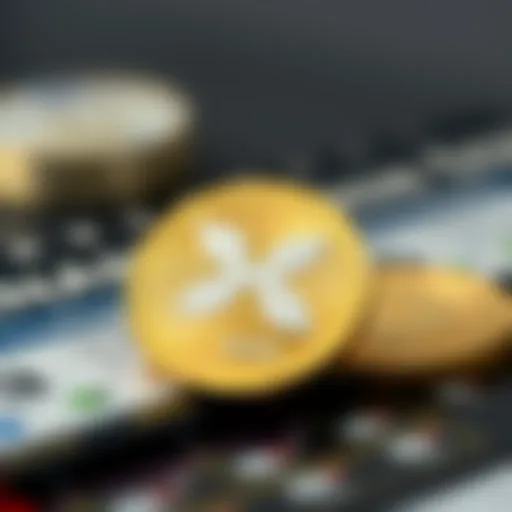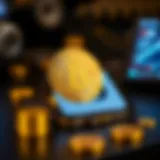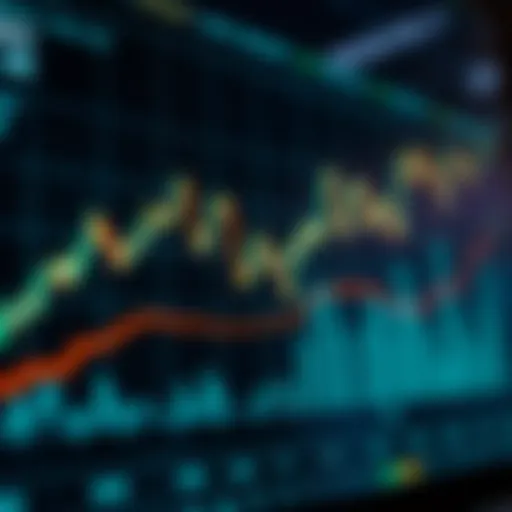Exploring the Impact of NFT Art in Today’s Market


Intro
In recent years, the art world has been rocked by the emergence of Non-Fungible Tokens, often referred to as NFTs. While traditional art has always had its complexities, this new digital form brings to light a myriad of questions regarding authenticity, ownership, and value. For the uninitiated, the world of NFT art might sometimes seem like a whirlwind of jargon and abstract concepts. However, even if you’re standing on the sidelines, the conversations surrounding NFT art are hard to ignore.
Artists, collectors, and investors alike have been drawn into this transformative landscape. From a seasoned art dealer to a novice artist exploring digital canvas, everyone seems to be keen on understanding how these tokens function and what they mean for both the market and culture. This article will break down these complexities, inviting you to dive deeper into the universe of NFT art pieces.
We will explore the key concepts that underpin NFTs, the technology that supports them, and how they fit into the evolving art market. We’re looking at everything from the ethical implications of NFTs to their practical applications in ensuring creative rights. As we embark on this journey, it’s essential to keep an open mind and be prepared to see how the lines between art, technology, and finance are being blurred.
Crypto Concepts Explained
Key Terminology and Definitions
Understanding NFT art begins with grasping the basic terminology. Non-Fungible Tokens are unique digital assets that represent ownership of a particular item or piece of content on the blockchain. Unlike Bitcoin or Ethereum, which are fungible and can be exchanged one-to-one, NFTs each hold their distinct characteristics.
Here are some essential terms to familiarize yourself with:
- Blockchain: A decentralized digital ledger that records all transactions across a network. In the case of NFTs, this ledger provides proof of ownership and authenticity.
- Minting: This refers to the process of creating an NFT from a digital file, making it available for purchase or sale.
- SMART contracts: These are self-executing contracts with the terms of the agreement directly written into code, enabling transactions without intermediaries.
- Gas Fees: Transaction fees paid to miners on a blockchain to validate transactions. These can fluctuate based on network activity.
Practical Applications of Blockchain Technology
NFTs are more than just digital art pieces; they also push the boundaries of how we think about ownership and provenance in art. Here are a few ways blockchain technology applies:
- Provenance Tracking: Each NFT has a history stored on the blockchain, which allows buyers to verify the originality and ownership history of an artwork. This can help prevent art fraud, a long-standing issue in the art market.
- Smart Royalties: Artists can program royalties into their NFTs, ensuring they earn a percentage of sales every time their piece is resold. This shifts the traditional profit model, keeping artists financially linked to their work long after the initial sale.
- Decentralized Marketplaces: Platforms like OpenSea and Rarible allow artists to sell directly to consumers, eliminating middlemen and giving artists greater control over their sales.
The confluence of these factors makes NFTs a powerful tool in the ecosystem of contemporary art. With every coin flip, a new narrative unfurls, and the implications for collectors and creators are profound.
Prelims to NFT Art
As we plunge into the intricate realm of digital creativity, NFT art stands out as a revolutionary manifesto, challenging traditional notions of creativity, ownership, and value. The topic of NFT art is especially significant in today’s evolving landscape, where artists and collectors alike are rethinking how art is created, shared, and sold. It sparks an exploration into how technology reshapes our appreciation for the arts, setting the stage for a comprehensive discussion throughout this article.
NFTs, or Non-Fungible Tokens, act as a bridge between artists and collectors, enabling direct transactions that cut through the red tape typically found in the art market. This not only democratizes access but also empowers creators to retain a stake in their work long after it's sold. Moreover, the sale of NFT art pieces has inspired a frenzy in the market, leading to astronomical prices and fierce debates over what constitutes 'value' in art.
This section will delve into two pivotal aspects of NFT art: what these digital treasures truly represent and the technology that undergirds them.
Defining NFT Art
At its core, NFT art bridges the divide between the digital and physical realms. A non-fungible token is an element secured on the blockchain, providing proof of ownership that is unique to each piece. This uniqueness establishes a digital signature, akin to a certificate of authenticity, which verifies the creator and validates the transaction history. Unlike traditional art, where a single painting can only belong to one owner at a time, NFTs can exist in the digital ether while being owned by various individuals simultaneously—this can be as simple as a digital image or as complex as an intricately designed game asset.
The appeal of NFT art lies in its potential for innovation, as artists explore different mediums beyond paint on canvas. Today, artists are experimenting with animations, interactive experiences, and even virtual reality, pushing the envelope of creativity as they dive into the depths of the digital world. For many creators, NFT art provides a novel avenue for income, resilience through ownership, and a global platform to showcase their talents.
The Role of Blockchain Technology
Blockchain technology, the backbone of NFTs, has transformed how digital goods are perceived and traded. Unlike traditional databases, blockchains are decentralized ledgers, making them immune to alteration and fraud. Blockchain technology assures that every transaction regarding a piece of NFT art is recorded, transparent, and verifiable by anyone, anywhere, at any time. This system not only generates a traceable line of ownership but also facilitates smart contracts that automate processes such as royalties—allowing artists to earn from future sales.
In recent years, many blockchain platforms have emerged, competing for dominance in the NFT space, with Ethereum being the most recognized due to its robust functionalities. This shift illustrates a growing trend, one that blends art, investment, and technology in novel ways.
"NFTs are not just a trend; they symbolize a paradigm shift in how we perceive ownership and value in the digital age."
The implications of this transformation reach far beyond art collectors. Investors, analysts, and developers are navigating this new terrain, analyzing market trends, identifying emerging opportunities, and adapting to changes in societal perceptions of art. As technology continues to evolve, the marriage of art and blockchain is poised to cultivate new ideas and invigorate the art scene for years to come.
Historical Context of NFTs
The narrative surrounding NFT art finds its roots deep within the broader journey of digital art and technology. This section serves to lay the groundwork, establishing why understanding this context is crucial for grasping the full impact of NFTs on the art world.
NFTs are not just a recent fad; they represent a pivotal moment in how art is created, owned, and valued. A proper look into the historical emergence and growth of NFTs reveals insights that are direly needed for artists, collectors, and investors alike. Without this foundation, discussions about today’s NFT art scene merely skim the surface.
The Origins of NFTs
The inception of NFTs can be traced back to the mid-2010s when early concepts began blossoming. Although digital art isn't a new phenomenon, the integration of blockchain technology introduced a unique twist. Originally, digital creators faced challenges with ownership and authenticity. With traditional mediums, the physical aspect offered a tangible proof of originality, which was sorely lacking in digital formats.


In 2017, the launch of CryptoPunks marked a significant milestone. These pixel art characters grasped the essence of uniqueness and ownership, showcasing the potential for blockchains to certify digital assets. This was followed closely by projects like CryptoKitties, further capturing the public’s imagination and drawing attention to the idea of "digital collectibles."
"NFTs transformed the digital art landscape, turning file sharing on its head and providing a genuine method for artists to gain recognition and profit from their work."
The general public began to take notice in 2021, when high-profile auctions highlighted how far NFTs had come from their humble beginnings. Beeple’s "Everydays: The First 5000 Days," which sold for $69 million, catapulted NFTs into the mainstream consciousness, addressing long-held questions of digital ownership.
Evolution of Digital Art
The trajectory of digital art itself plays a critical role in understanding NFTs. From gifs shared on forums to minimalist digital paint strokes on a canvas, artists have explored various mediums over decades. Notably, the 1990s birthed websites like DeviantArt, cultivating a community where artists shared their creations, albeit often without appropriate compensation.
The 2000s saw the rise of social media platforms where digital art began to flourish, although monetization remained an elusive dream for many. As artists turned to platforms like Instagram or Behance to showcase their work, the lingering issue of ownership still hovered ominously. Uncompensated sharing of digital work plagued the scene, which ultimately stifled creativity for many artists.
When NFTs came into the picture, they shifted the paradigm dramatically. Digital art pieces, which were often seen as "valueless" due to their shareability, suddenly had an avenue for recognition and profit. Artists could now attach their identity, their brand, directly to their works, generating not just a one-time sale but also ongoing royalties via the blockchain.
In summary, recognizing the historical context of NFTs not only provides clarity to the evolution of art but also reveals the ethical and cultural upheaval that they have incited. This understanding paves the way for deeper discussions surrounding NFT art, its current realities, and future potentials. It allows investors, collectors, and artists to navigate this evolving landscape more effectively.
Economic Implications of NFT Art
The rise of NFT art has transformed the economic landscape of the art world in significant ways. As digital ownership becomes more tangible through blockchain technology, artists and collectors alike find themselves navigating new waters filled with opportunities and challenges. The economic implications of NFT art are vast, impacting not just individual artists but also collectors, galleries, and the market as a whole. This section delves into key aspects such as market trends, valuation metrics, and investment strategies that are shaping this burgeoning environment.
Market Trends and Valuation
The NFT art market has seen unprecedented growth over the past few years, with some pieces fetching mind-boggling prices and auction records shattered on platforms like OpenSea and Rarible. For instance, the sale of Beeple's "Everydays: The First 5000 Days" for $69 million at Christie’s made waves, signaling that digital art can command real-world value.
Several factors are driving this market surge:
- Increased Accessibility: Various platforms have emerged, allowing not just established artists but also emerging ones to sell directly to consumers without intermediary galleries.
- Collector Enthusiasm: NFTs appeal to a new generation of collectors who value unique digital ownership. This enthusiasm is reflected in rising prices and a growing community around NFT art.
- Speculative Investments: Many investors view NFTs as a new asset class. The volatile nature of the crypto market often influences NFT values, leading to fierce speculation.
Valuation in the NFT market is not straightforward. Unlike traditional art, which may rely on appraisal or historical sales data, NFT valuations can hinge on several criteria:
- Scarcity: Limited editions or one-of-a-kind pieces tend to command higher prices.
- Artist Reputation: Established artists may see their NFT works valued higher than those of newcomers.
- Trend Cycles: The zeitgeist can play a massive role as trends shift rapidly, causing values to fluctuate wildly.
"When it comes to NFTs, the value often lies not just in the art itself, but in the narrative behind it. The perception of uniqueness and ownership elevates its worth beyond mere pixels on a screen."
Investment Strategies in NFT Art
Investing in NFT art is no small feat. For collectors and investors eager to dive in, comprehending the market dynamics and developing sound strategies is crucial. Here are several approaches to consider:
- Diversity in Collections: Just like in traditional investing, it’s wise to avoid putting all your eggs in one basket. A range of styles, artists, and platforms can hedge against market volatility.
- Research and Community Engagement: Understanding trends involves not just observing sales but also engaging with communities on platforms like Discord and Twitter. These interactions can provide insights into emerging talents and market shifts.
- Timing Purchases: Awareness of market cycles can help investors find opportunities. Buying during a market dip or before a hype cycle can maximize returns.
- Long-Term Vision: Unlike stocks, NFTs mean holding onto digital assets for potentially longer, waiting for the right moment for resale. Patience can be a key virtue in this volatile market.
Cultural Dimensions of NFT Art
The emergence of NFT art introduces a fresh lens through which we can view ownership, creativity, and culture itself. It highlights a substantial shift, not just in how we think about art, but also in how it interacts within society and cultural frameworks. This section aims to probe deeper into the nuanced cultural dimensions of NFTs, considering the transformation in perceptions of ownership and the global dynamics at play.
Shifting Perceptions of Art Ownership
The very concept of ownership has evolved dramatically with the introduction of NFTs. Traditionally, owning art meant having a tangible piece—a canvas on a wall or a sculpture gracing a garden. However, with NFT art, ownership is more abstract, revolving around digital certificates that denote authenticity and provenance.
This change can be likened to the rise of music streaming services. Just as listeners shifted from owning physical albums to subscribing to platforms like Spotify or Apple Music, art collectors are now purchasing licenses or tokens to pieces rather than the objects themselves. People increasingly recognize that value can exist beyond physicality.
One significant result of this shift is the democratization of art. Artists from diverse backgrounds now can monetize their work without relying on traditional art institutions. An example is the story of Beeple, whose piece "Everydays: The First 5000 Days" fetched over $69 million at auction, thereby illustrating how individuals can attain global fame through digital platforms. Nevertheless, with these changes come questions around the implications of such ownership—who truly owns the rights? Can one replicate the art while still respecting the creator's initial rights?
"NFTs challenge the status quo, inviting fresh discussions about value, authorship, and accessibility."
The Global Phenomenon of NFTs
NFTs have taken the world by storm, transcending geographical boundaries and engaging individuals and communities far and wide. The cultural implications of this phenomenon cannot be overstated. From seasoned collectors in New York to artists in rural Africa, the NFT market has created a global conversation around digital art as a legitimate form of expression and investment.
The global nature of NFTs allows diverse voices to contribute to the art scene. Collaborations across continents, cultures, and mediums are becoming increasingly commonplace. One could argue that NFTs are bridging gaps that traditional galleries have often overlooked, providing a platform for diverse narratives and stories.


Regions that might have previously struggled for recognition in the conventional art world are now making their mark in the NFT sector. For instance, artists from countries like Nigeria and India are leveraging NFT platforms to showcase their rich heritage, blending traditional styles with modern digital techniques.
Key factors contributing to this phenomenon include:
- Accessibility: Anyone with an internet connection can participate in the NFT market, regardless of location.
- Community Building: Artists and collectors often form online communities, fostering collaboration and support.
- Cultural Exchange: NFTs provide a space for dialogue and exchange between different cultures, leveraging global trends to address local issues.
Legal and Ethical Considerations
In today's digital landscape, legal and ethical considerations surrounding NFT art have become more crucial than ever. This section delves into the intricate web of rights, responsibilities, and societal impacts that come into play in the world of NFTs, especially focusing on how these elements shape the experiences of creators and collectors alike. As NFT art gains traction, understanding these aspects can empower artists to navigate the challenges while maximizing their creative potential.
Copyright Issues with NFT Art
Copyright is a hot topic in the realm of NFT art. When someone buys an NFT, they typically receive proof of ownership for a digital asset. However, this does not automatically transfer the copyright associated with the artwork. In many cases, artists can retain their copyright, meaning the buyer does not gain the right to reproduce or sell the piece without the artist's permission.
- Creator's Rights: Artists must clearly outline the terms of use when they mint their NFTs. This means explicitly stating what rights transfer to the buyer or what remains with the creator.
- Buyer's Responsibilities: Collectors should also be diligent. If they're unclear on the rights being transferred, they could inadvertently overstep legal boundaries. Keeping track of these nuances is critical for both buyers and artists.
- Legal Precedents: Legal battles over copyright can set significant precedents. As more artists embrace NFTs, courts may be called upon to define how traditional copyright principles apply in this new digital context.
Given the evolving nature of copyright law and digital ownership, it's essential for stakeholders to stay informed about changes and emerging legal frameworks.
"The lack of clarity in copyright law regarding digital assets can lead to disputes that, if not addressed, could hinder the growth of the NFT art market."
Environmental Impact of Blockchain
The environmental critique of blockchain technology cannot be glossed over. This is particularly troubling given that many NFT platforms utilize energy-intensive proof-of-work mechanisms for their transactions. The concern lies in how this impacts our planet, given the growing urgency of climate change.
- Energy Consumption: Mining cryptocurrencies requires a vast amount of electricity, which can lead to higher carbon emissions. This has become a focal point in discussions around the sustainability of NFTs.
- Shifts in Technology: In response to these concerns, some platforms are now exploring more environmentally friendly alternatives, such as proof-of-stake models. These alternatives require significantly less energy, potentially mitigating some of the environmental harm associated with NFTs.
- Market Responsibility: Collectors and artists now find it imperative to understand the environmental impact of their choices. This means not only considering the art itself but how and where it's minted.
Addressing the environmental considerations of NFTs is necessary for fostering a responsible art market that values both creativity and sustainability.
Technological Innovations in NFT Art
The realm of NFT art isn't simply a product of the creative mind; it stands as a testament to what technology can do. Innovations in this space have dramatically reshaped not just how art can be created, bought, and sold, but also how we experience it. By examining the specific elements that underpin these technological advances, we can grasp their significance and the benefits they promise to various stakeholders.
New Platforms for NFT Distribution
The rise of NFT art cannot be divorced from the new platforms that facilitate its distribution. These platforms serve as digital galleries where artists can showcase their work, collectors can browse and purchase, and enthusiasts can engage. Platforms like OpenSea, Rarible, and SuperRare have emerged as leaders in this digital marketplace. They enable a global audience to discover and acquire unique pieces through seamless transactions on blockchain.
One crucial element of these platforms is the ability to create and list NFTs with varying levels of complexity and functionality. For example, some platforms allow artists to embed royalties into their smart contracts. This means every time an artwork is resold, the original artist benefits from a percentage of the sale. It is a game-changer because it aligns the economic interests of both the creators and the collectors.
Another significant aspect is community features that many of these platforms embrace. By leveraging social tools, artists and collectors can engage in dialogue, receive feedback, and create followerships—turning mere transactions into richer interactions. To illustrate this, sharing insights on platforms like Reddit or Twitter can develop a buzz around a particular artist or artwork, which drives demand and adds to its value.
This engagement illustrates how new platforms are doing more than just facilitating sales; they are building communities that foster interaction between creators and collectors.
Integration with Virtual Reality
The integration of NFT art with virtual reality (VR) presents an exciting frontier that turns conventional notions of art viewing on their head. Imagine stepping into a virtual space where you can walk through an art gallery filled with NFTs in a fully immersive environment. VR technologies are gradually making this vision a reality, enhancing the art experience for collectors and artists alike.
By combining NFTs with VR, creators are able to explore multi-dimensional storytelling. A piece of art could not only be seen but also experienced interactively. For example, an artist could design installations where viewers can manipulate elements of the artwork in real time, creating a customized experience. This shifts the audience's role from passive observer to active participant.
The benefits of this integration extend into the commercial aspect as well. Artists can potentially reach new markets through virtual exhibitions that bypass geographical constraints. There's a rich opportunity here for educational initiatives too—VR can provide an avenue for art education well beyond traditional boundaries.
Case Studies of Prominent NFT Art Pieces
Exploring the case studies of prominent NFT art pieces unearths invaluable lessons and insights into the rapidly evolving digital art landscape. This section underscores the significance of understanding the interplay between individual artists, their works, and the market dynamics at play. When one looks at how certain pieces have captured the public's imagination and driven financial investment, it becomes evident that this exploration serves multiple purposes. It highlights not only artistic creativity but also sheds light on economic patterns and cultural shifts within this innovative space. By analyzing these case studies, investors, analysts, and creators alike can gain a better grasp on how to navigate the NFT art world.
Notable Artists and Their Works
NFT art has become synonymous with a new breed of artist, ones who merge technology with creativity. A few names rise above the noise, often becoming symbols of this digital revolution. Take Beeple, for instance. His piece "Everydays: The First 5000 Days" sold for a staggering $69 million at auction, paving the way for many collectors and enthusiasts. His art integrates digital collage techniques and reflects contemporary societal issues, setting a benchmark for future NFT creators.
Another notable artist is Pak, who engages the audience is a unique manner through his works. The intriguing "Merge" sold for over $91 million in a groundbreaking auction on Nifty Gateway, inviting collectors to snatch up 'units' of the piece rather than a single whole work. This notion transforms ownership into a shared experience, representing a shift in how art can be consumed digitally.


- Important Artists in the NFT Space:
- Beeple (Mike Winkelmann)
- Pak
- Trevor Jones
- XCOPY
These artists embody the innovative spirit that NFTs represent. Each work crafted is not just visually stunning but also layered with meaning, connecting with their audience on a broader scale.
Significant Sales and Impact
The sales of prominent NFT art pieces have created ripples across the entire art world. These transactions not only trigger heightened interest but also reshape perceptions about the value of digital art.
A clear example is the sale of “CryptoPunk #7804,” which fetched around $7.6 million, establishing the Punk series as a prestigious collection among investors. This sale resonates beyond its financial value; it reinforces the cultural status of digital assets.
"The future of art may not be on canvas or stone, but on the blockchain."
The impacts of these significant sales can be categorized into a few key areas:
- Market Validation: High-profile sales bolster confidence in the NFT market, encouraging both new and seasoned investors to participate.
- Cultural Shifts: The acceptance of digital art pieces as legitimate can elevate the dialogue around art in the digital age, urging traditional art scenes to adapt.
- Investment Strategies: As more investors turn to digital assets, understanding market trends and valuations becomes imperative, positioning NFT art as an essential component of modern portfolios.
This case study examination paves the way for a comprehensive understanding of where NFT art stands today and hints at the direction it may take in the future. Addressing both the artists and sales helps the audience comprehend what makes NFT art a significant element in the contemporary art discussion.
Challenges Facing the NFT Art Market
The NFT art market stands on the threshold of innovation and ambiguity. As artists and collectors alike dive into this new realm, numerous challenges present themselves, creating a complex environment that demands careful navigation. Understanding these obstacles is essential for anyone looking to engage with NFTs, whether they are investors with an eye on potential profits, creators excited by new avenues for expression, or collectors hoping to secure unique pieces. This section delves into two primary challenges: market speculation and volatility, along with fraud and authenticity issues—each critical in shaping perceptions of this emerging marketplace.
Market Speculation and Volatility
Market speculation in NFT art is a double-edged sword. On one side, the buzz and energy surrounding high-profile sales often drive significant interest and investment—a powerful engine for any burgeoning market.
However, this very excitement can lead to extreme volatility. Prices often seem to swing wildly, influenced by trends that can appear and vanish in the blink of an eye. There are reports of pieces being sold for millions one day—only to find that value plummeting the next as the fad changes.
For instance, take the case of a digital artwork that once sold for $69 million. The public was in a frenzy, and it spotlighted the potential of digital ownership. Yet soon after, many NFT artworks went on to struggle in terms of resale value, as buyers found themselves in a speculative bubble that burst rapidly.
"The NFT sector is such a new and fluctuating space, making it a gamble for many. Investors must tread carefully and critically assess their involvement."
Here are some considerations for those entering the market:
- Understanding Market Drivers: Familiarize yourself with what fuels enthusiasm. Is it social media buzz, celebrity endorsements, or perhaps trends in the digital art world?
- Balance of Investment and Passion: While being drawn to the potential profits, it’s vital to not overlook the artistic value of the pieces.
- Research and Due Diligence: Look beyond the surface. Check history and performance trends—what is the track record for specific types of NFT art?
Fraud and Authenticity Issues
The specter of fraud looms large in the NFT art marketplace. Given that these assets are digital, the line between original and counterfeit can sometimes appear clinically thin. Artists, collectors, and investors have faced a myriad of challenges in ensuring authenticity, leading to substantial concerns within the community.
One prominent issue has been the minting of NFTs without the creator's consent. Unscrupulous actors may take existing works and reissue them as NFTs, leading buyers to invest in stolen art. This risk creates a climate of mistrust, which can deter new investors from entering the market.
Authentication, traditionally established through physical inspections and provenance documentation in conventional art, lacks a robust equivalent in the digital sphere. Many are left to rely on trust and reputations. To combat these challenges, the industry must adopt more rigorous standards for verifying the origination of art and its rightful ownership. Establishing more comprehensive platforms for verification could pave the way for increased confidence.
- Stay Educated: Familiarize yourself with the current trends in security and technology. Knowledge is a powerful tool against fraud.
- Emphasize Established Platforms: Opt for reputable NFT marketplaces that undertake stringent measures for artist verification and ownership rights.
- Secure Your Work: Artists should explore secure ways to mint their artworks to safeguard against unauthorized reproductions.
Future of NFT Art
The future of NFT art presents a horizon filled with both challenges and breakthroughs. As the industry continues to evolve, understanding the emerging trends and potential regulatory changes becomes crucial for artists, investors, and collectors alike.
NFT art is poised to redefine various aspects of the traditional art market, unlocking new avenues for creativity and investment. The decentralized nature of NFTs grants artists unprecedented control over their works and opens up opportunities for revenue streams that were previously unavailable. This is not just a fad; it’s reshaping how art is created, bought, and sold.
Emerging Trends to Watch
To grasp the trajectory of NFT art, it's important to keep an eye on several emerging trends:
- Interactivity in Art: As technology advances, artists are experimenting more with interactive NFTs, where the viewer can engage with the art piece. This could mean anything from altering the artwork via inputs to experiencing varying versions of the art based on viewer engagement.
- Integration with Gaming: NFTs are finding a comfortable home in the gaming industry, where players can purchase in-game assets as unique collectibles. This move not only enhances the gaming experience but also provides a real value to digital items, allowing gamers to trade or sell them outside the game environment.
- Fractional Ownership: The idea of splitting ownership among multiple buyers is gaining traction. With fractional ownership, collectors get a chance to invest a smaller amount in high-value art pieces, democratizing access to art that was once reserved for the elite.
- Environmental Sustainability: There is a growing effort for environmentally-conscious practices within the NFT space, including the use of eco-friendly blockchains. Artists and platforms are advocating for greener solutions to counteract the carbon footprint often associated with blockchain technology.
"The NFT landscape is not just about buying and selling; it's about reshaping the very nature of ownership in the digital age."
Potential Regulatory Developments
As the popularity of NFTs surges, regulatory frameworks are expected to evolve alongside the market. Here are a few key considerations that could unfold:
- Intellectual Property Laws: With digital assets exploding in popularity, lawmakers are challenged to define the boundaries of intellectual property. New regulations may clarify how creators and collectors can protect their rights in the digital realm, helping to resolve issues of copyright that have been trickling into the industry.
- Taxation: The rise of trading NFTs will likely provoke responses from tax authorities. Individuals might see tighter regulations regarding the reporting of NFT transactions, especially for those buying and selling as a business.
- Consumer Protections: As more individuals invest in NFTs, there may be an increased call for consumer protections against fraud and scams. This could lead to the establishment of standards for NFT marketplaces, enhancing trust within the community.
- KYC (Know Your Customer) Regulations: With the increasing adoption of NFTs and growing concerns over money laundering, platforms may adopt stricter KYC norms. Artists and buyers might have to provide identification to engage in transactions and trade, a substantial shift from the current anonymity enjoyed in many markets.















